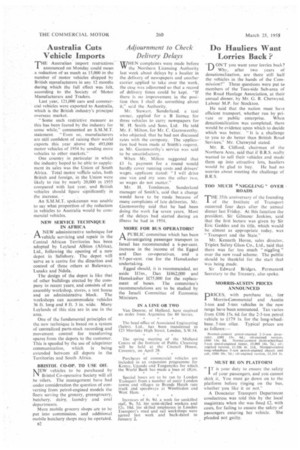Australia Cuts Vehicle Imports
Page 28

If you've noticed an error in this article please click here to report it so we can fix it.
THE Australian import restrictions announced on Monday could mean a reduction of as much as 15,000 in the number of motor vehicles shipped by British manufacturers in any 12 months during which the full effect was felt, according to the Society of Motor Manufacturers and Traders.
Last year, 121,000 cars and commercial vehicles were exported to Australia, which is the British industry's principal overseas market "Some such restrictive measure as this has been feared by the industry for some while," commented an S.M.M.T. statement. "Even so, manufacturers are still confident of raising their world exports this year above the 493,000 motor vehicles of 1954 by sending more vehicles to other markets."
One country in particular in which the industry hoped to be able to supplement its sales was the Union of South Africa. Total motor veltcle sales, both British and foreign, in the Union were likely to rise by nearly 20,000 in 1955 compared with last year, and British vehicles should figure significantly in the increase.
An S.M.M.T. spokesman was unable to say what proportion of the reduction in vehicles to Australia would he commercial vehicles.
NEW SERVICE TECHNIQUE IN AFRICA
ANEW administrative technique for vehicle servicing and repair in the Central African Territories has been adopted by Leyland Albion (Africa), Ltd.. following the opening of a new depot in Salisbury. The depot will serve as a centre for the direction and control of three others at Bulawayo, Lusaka and Ndola.
The design of the depot is like that of other buildings erected by the company in recent years, and consists of an assembly workshop, stores, a test house and an administrative block. The workshops can accommodate vehicles 36 ft. long and 8 ft. 3 in. wide. Many Leylands of this size are in use in the area.
One of the fundamental principles of the new technique is based on a system of centralized parts-stock recording and movement control for transferring spares from the depots to the customer. This is speeded by the use of teleprinter communication, which is being extended between all depots in the Territories and South Africa.
BRISTOL CO-OP. TO USE OIL
NEW vehicles to be purchased by Bristol Co-operative Society will all be oilers. The management have had under consideration the question of converting from petrol-engined models the fleets serving the grovery, greengrocery, butchery, dairy, laundry and coal departments.
More mobile grocery shops are to be put into commission, and additional mobile butchery shops may be operated. n2
























































































